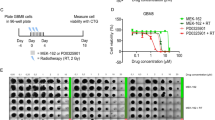Abstract
Irradiation is one of the cornerstones used in the treatment of malignant glioma. However, the effect is modest and glioma cells generally display a pronounced radio-resistance. In this study, the effect of irradiation, alone and in combination with the antimicrotubule drug estramustine (EaM), was investigated in vitro using the BT4C rat glioma cell line, and in vivo the BT4C rat intracerebral glioma model was used. Apoptosis was detected by analysing DNA laddering, in situ end labelling (ISEL) and Annexin V reactivity. In addition, phosphorylation status of MAPK, JNK, p38, and AKT, proteins involved in pro- and anti-apoptotic signalling pathways was analysed by Western blotting. Irradiation did not induce apoptosis, neither in vitro nor in vivo. EaM, however, induced apoptosis in vivo and in vitro, regardless of whether EaM was given alone, before or after irradiation. When BT4C cells were treated with the caspase-3 inhibitor Ac-DEVD-CHO prior to EaM, the number of apoptotic cells was decreased, indicating an involvement of caspase-3. The signalling pathways regulating apoptosis are complex and involve kinases such as MAPK, JNK, p38 and AKT. Irradiation did not induce any changes in the expression levels or phosphorylation status of these proteins. On the other hand, the phosphorylation level of AKT was reduced after EaM treatment, which might, in part, propose how EaM induces apoptosis in glioma cells.
Similar content being viewed by others
References
Yang X, Darling JL, McMillan TJ, Peacock JH, Steel GG: Radiosensitivity, recovery and dose-rate effect in three human glioma cell lines. Radiother Oncol 19: 49-56, 1990
Stapper NJ, Stuschke M, Sak A, Stuben G: Radiation-induced apoptosis in human sarcoma and glioma cell lines. Int J Cancer 62: 58-62, 1995
Warters RL: Radiation-induced apoptosis in a murine T-cell hybridoma. Cancer Res 52: 883-890, 1992
Yamada T, Ohyama H: Radiation-induced interphase death of rat thymocytes is internally programmed (apoptosis). Int J Radiat Biol Relat Stud Phys Chem Med 53: 65-75, 1988
Bergenheim AT, Elfersson J, Gunnarsson P, Edman K, Hartman M, Henriksson R: Cytotoxic effect and uptake of estramustine in a rat glioma model. Int J Oncol 5: 293-299, 1994
Bergenheim AT, Gunnarsson PO, Edman K, von Schoultz E, Hariz MI, Henriksson R: Uptake and retention of estramustine and the presence of estramustine binding protein in malignant brain tumours in humans. Br J Cancer 67: 358-361, 1993
Piepmeier JM, Keefe DL, Weinstein MA, Yoshida D, Zielinski J, Lin TT, Chen Z, Naftolin F: Estramustine and estrone analogs rapidly and reversibly inhibit deoxyribonucleic acid synthesis and alter morphology in cultured human glioblastoma cells. Neurosurgery 32: 422-430, discussion 43, 1993
von Schoultz E, Lundblad D, Bergh J, Grankvist K, Henriksson R: Estramustine binding protein and antiproliferative effect of estramustine in human glioma cell lines. Br J Cancer 58: 326-329, 1988
Bergenheim AT, Zackrisson B, Elfverson J, Roos G, Henriksson R: Radiosensitizing effect of estramustine in malignant glioma in vitro and in vivo. J Neuro-Oncol 23: 191-200, 1995
Bjermer L, von Schoultz E, Norberg B, Henriksson R: Estramustine inhibits monocyte phagocytosis. Prostate 13: 49-55, 1988
Dahllöf B, Billström A, Cabral F, Hartley-Asp B: Estramustine depolymerizes microtubules by binding to tubulin. Cancer Res 53: 4573-4581, 1993
Stearns ME, Wang M, Tew KD, Binder LI: Estramustine binds a MAP-1-like protein to inhibit microtubule assembly in vitro and disrupt microtubule organization in DU 145 cells. J Cell Biol 107: 2647-2656, 1988
Yoshida D, Hoshino S, Shimura T, Takahashi H, Teramoto A: Drug-induced apoptosis by anti-microtubule agent, estramustine phosphate on human malignant glioma cell line, U87MG; in vitro study. J Neuro-Oncol 47: 133-140, 2000
Vallbo C, Bergenheim AT, Bergström P, Gunnarsson PO, Henriksson R: Apoptotic tumor cell death induced by estramustine in patients with malignant glioma. Clin Cancer Res 4: 87-91, 1998
Chen YR, Meyer CF, Tan TH: Persistent activation of c-Jun N-terminal kinase 1 (JNK1) in gamma radiation-induced apoptosis. J Biol Chem 271: 631-634, 1996
Laerum O, Rajewsky M, Schachner M, Stavrou D, Haglid K, Haugen A: Phenotypic properties of neoplastic cell lines developed from fetal rat brain cells in culture after exposure to ethylnitrourea in vivo. Zellular Krebsforsch Klin 89: 273-295, 1977
Vallbo C, Bergenheim T, Bergh A, Grankvist K, Henriksson R: DNA fragmentation induced by the antimitotic drug estramustine in malignant rat glioma but not in normal brain-suggesting an apoptotic cell death. Br J Cancer 71: 717-720, 1995
Yount GL, Haas-Kogan DA, Levine KS, Aldape KD, Israel MA: Ionizing radiation inhibits chemotherapy-induced apoptosis in cultured glioma cells: implications for combined modality therapy. Cancer Res 58: 3819-3825, 1998
Yoshida D, Piepmeier J, Weinstein M: Estramustine sensitizes human glioblastoma cells to irradiation. Cancer Res 54: 1415-1417, 1994
Chen YR, Wang X, Templeton D, Davis RJ, Tan TH: The role of c-Jun N-terminal kinase (JNK) in apoptosis induced by ultraviolet C and gamma radiation. Duration of JNK activation may determine cell death and proliferation. J Biol Chem 271: 31929-31936, 1996
Chmura SJ, Nodzenski E, Beckett MA, Kufe DW, Quintans J, Weichselbaum RR: Loss of ceramide production confers resistance to radiation-induced apoptosis. Cancer Res 57: 1270-1275, 1997
Shu HK, Kim MM, Chen P, Furman F, Julin CM, Israel MA: The intrinsic radioresistance of glioblastoma-derived cell lines is associated with a failure of p53 to induce p21(BAX) expression. Proc Natl Acad Sci USA 95: 14453-14458, 1998
Tsang NM, Nagasawa H, Li C, Little JB: Abrogation of p53 function by transfection of HPV16 E6 gene enhances the resistance of human diploid fibroblasts to ionizing radiation. Oncogene 10: 2403-2408, 1995
Downward J: Mechanisms and consequences of activation of protein kinase B/Akt. Curr Opin Cell Biol 10: 262-267, 1998
Enomoto A, Suzuki N, Hirano K, Matsumoto Y, Morita A, Sakai K, Koyama H: Involvement of SAPK/JNK pathway in X-ray-induced rapid cell death of human T-cell leukemia cell line MOLT-4. Cancer Lett 155: 137-144, 2000
Author information
Authors and Affiliations
Rights and permissions
About this article
Cite this article
Vallbo, C., Bergenheim, T., Hedman, H. et al. The Antimicrotubule Drug Estramustine but not Irradiation Induces Apoptosis in Malignant Glioma Involving AKT and Caspase Pathways. J Neurooncol 56, 143–148 (2002). https://doi.org/10.1023/A:1014562503097
Issue Date:
DOI: https://doi.org/10.1023/A:1014562503097




